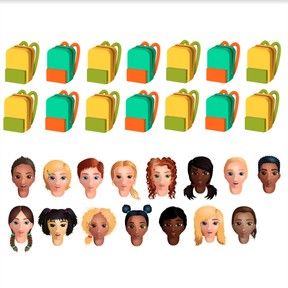
Recognizing not enough and too many to 20
Recognizing not enough and too many to 20



8,000 schools use Gynzy
92,000 teachers use Gynzy
1,600,000 students use Gynzy
General
Students learn to compare amounts from 1 to 20 with each other and know when there are not enough or too many.
Common core standard(s)
1.NBT.B.3
Relevance
Discuss with students why it is important to know which amount is bigger and when you have to much or not enough. You need this, for example, to know if there are enough chairs in a classroom for all the students.
Introduction
The interactive whiteboard has baby chicks in a disorganized fashion. Ask students how many baby chicks there are.
Development
Explain that if you want to know if you have enough of something, you must count both quantities. You compare these numbers. Explain the terms 'not enough' and 'too many'. Explain that when you want to know if you have enough of something, you have to count both quantities. Then you compare these two amounts. Explain the terms 'not enough' and 'too many'. If there is not enough, the number of objects you want to share for example, is smaller than the number of people you want to share with. There are not enough objects to share. If you have too much, the number of objects you want to share for example is bigger than the number of people you want to share with. You have objects left over. Clarify this explanation by using the examples on the interactive whiteboard. As a class, count the bananas and the children. There are more children than bananas, and so there are not enough bananas. Then count the tablets and children. There are less children than tablets, so there is one tablet too many.
Check that students can recognize not enough/too many in amounts up to 20 by asking the following questions:
- How do you know if there are enough?
- What does "too much" mean?
- What does "not enough" mean?
Guided Practice
Students practice using the worksheet. The amounts start smaller and become bigger.
Closing
Discuss with students what the importance of being able to compare amounts is again. You can use this to see if there are enough candies to share with all the children. Check that students know that they first need to count both amounts, and then compare the two numbers. To check that students have understood, show a few examples on the board. The students must indicate if there are not enough or too many balls for the children, or ingredients for a recipe.
Teaching Tip
Students who have trouble recognizing not enough/too many can draw a line from the object to the student on their worksheets. That way they have visual support for the numbers being compared.
The online teaching platform for interactive whiteboards and displays in schools
Save time building lessons
Manage the classroom more efficiently
Increase student engagement
Discover more!
About Gynzy
Gynzy is an online teaching platform for interactive whiteboards and displays in schools.
With a focus on elementary education, Gynzy’s Whiteboard, digital tools, and activities make it easy for teachers to save time building lessons, increase student engagement, and make classroom management more efficient.



